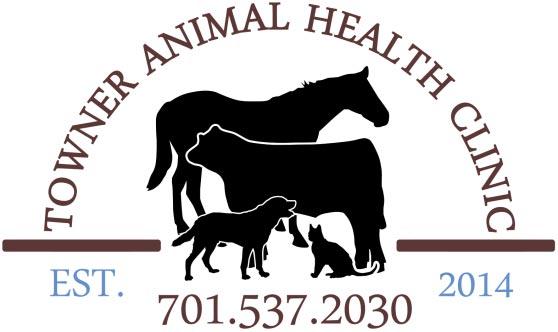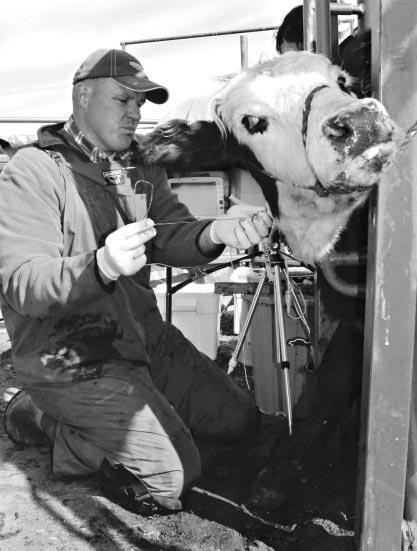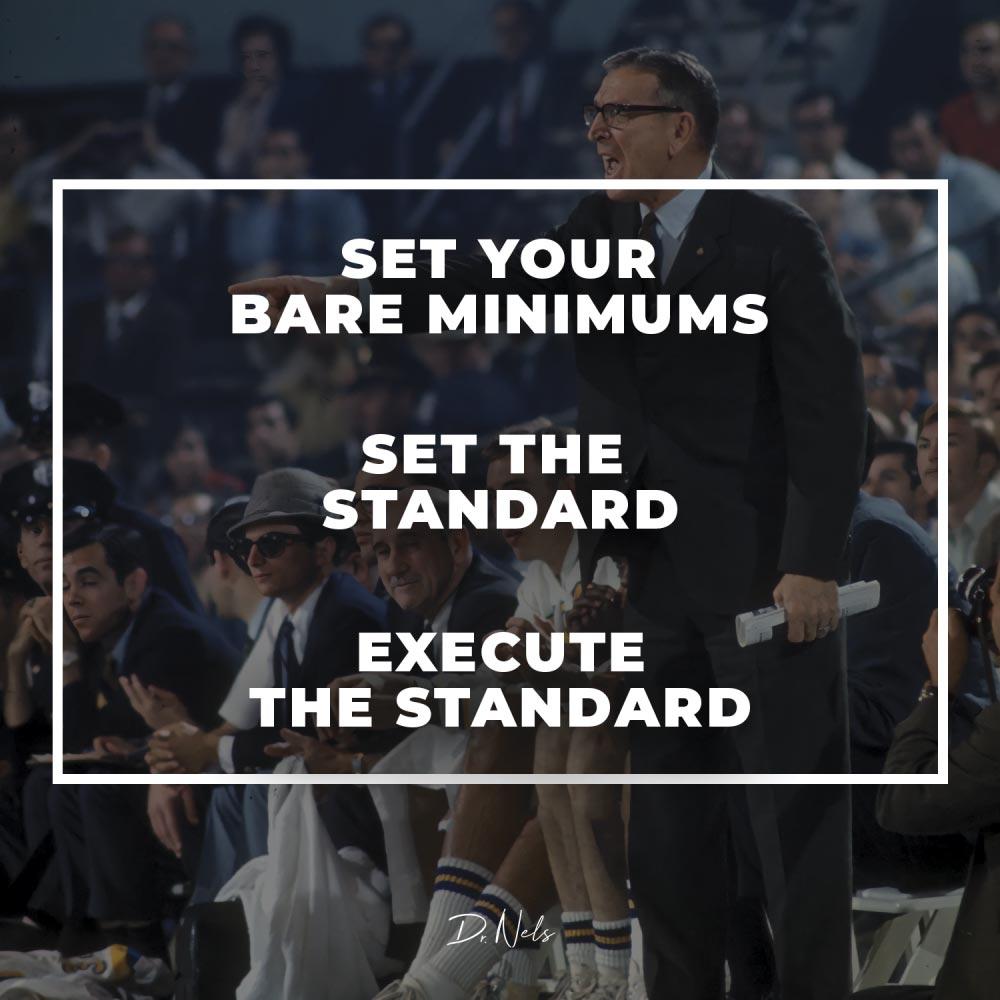
6 minute read
MIKE GAMBLE, DVM
Uinta Veterinary Services Roosevelt, Utah
Dr. Mike Gamble’s practice, Uinta Veterinary Services, is nestled in the southern foothills of the largest mountains in Utah, the Uinta Mountains, and situated on the border of the Uintah-Ouray Indian Reservation. The practice is based in Roosevelt, Utah, and serves clients over about 3,100 square miles, focused primarily on about 900 square miles.
Dr. Gamble loves to brainstorm and dream and then break those dreams down into actionable steps and watch things grow from the ground up. He has applied this many times while building his practice, and adding expertise and services to help their clients. He and his team strive to embody the core values of faith, heart, humility, service, fun, family, education, and communication.
Like many veterinarians, Dr. Gamble has more than one story involving a rowdy bull. In addition to the excitement and variability of veterinary practice, he really enjoys having fun and helping people reach their production goals. He shared, “I love the ‘salt-of-the-earth’ people that I get to work with. I love being out in the truck traveling from ranch to ranch and taking in God’s creation. I love the lifelong friendships that come when I am able to make little adjustments to people’s management plans and see big results. For instance, instituting the Sandhills Calving Rotation mentality has saved a lot of calves and elevated me to ‘hero’ status. (Just a little humor there!) All kidding aside, it really has created lifelong friendships with amazing people that I would invite to Sunday dinner anytime.”

Over three years ago, I wrote a book on hiring. At the time of writing, I had spent 10 years acquiring the knowledge and expertise necessary to write it. I wrote the book in an effort to fill a void I experienced as a leader, which was a lack of resources about how to successfully hire people. But as I was writing the book, the environment in the workforce reached a
By Nels Lindberg, DVM, Production Animal Consultation

ARE WE ACCEPTING MEDIOCRITY?
new level of scarcity with fewer and fewer people coming in the door to apply for a job. My mind had already shifted past hiring to thinking about how to retain the team members we do have. As leaders, we can think of people over the course of our careers that we wish we never would have lost. Fifteen to twenty years ago, it may not have been a big deal because it was simpler to find new team members to replace them. Today, not so much.
My mind had already shifted past hiring to thinking about how to retain the team members we do have.
Over the past several years and particularly in the last two years, I have had more conversations than ever with leaders about what we are willing to put up with in order to keep people on our teams. A few months ago, I was at a feedyard talking to a cowboy bunk-side when he shared his concerns about one of his teammates being late every day. He was unhappy about it, and it seemed like leadership wasn’t doing anything about it. As we were talking, the cowboy in question showed up at 8:00 am, driving past us en route to the horse barn. As you can imagine, the manager knew this was taking place but wasn’t sure how to handle it. They were significantly short on help. The non-compliant cowboy was a good hand and did good work. He was just routinely late.
Can you think of a team member like this? A team member that performs the expectations of the job very well for the most part but has one significant behavioral trait that does not meet the team’s needs or really annoys you? Maybe they show up late periodically, or they aren’t the best team player and ride off by themselves with their own plan. Perhaps they create drama by talking badly about others when they are oneon-one horseback, riding down the alley. Or maybe they are always sick on the really cold days. Do any of those scenarios sound familiar? Have you also found yourself negotiating with yourself, “Just what am I willing to accept out of this person because I need the help!?”
Each of you reading this article knows this is a common problem and a challenge for yourself and for your leaders. The following is an attempt to give you some key items to consider, discuss, and put into action. This list will help set some boundaries and a bare minimum set of standards that all team members must meet to stay on your incredible team! Remember, we have to address the issue; otherwise, those team members that “catch you bunk-side” and make their concerns known will leave us. We must do something, or at least let them know we are working on a path forward to address their concerns.
1. Install two of John Wooden’s three rules: Never be late. Never criticize a teammate. If you want two bare minimum rules to apply to any team, these are two that won’t fail you. The start of the day sets the tone for the yard. If we have people arriving late and not holding up their end of the bargain, they can’t be on the team. In the situation I shared above, we took action that day to address the team member’s lateness. We applied focus and had frank and candid conversations with him. This same cowboy is now on time! If we want any level of quality teamwork, we must ask our people to respect each other, no matter their opinions or likeability. No one should ever criticize a teammate. Criticizing one teammate to another teammate is simply gossip and only further destroys them and the team. We can’t have that, and we need to install this very basic fundamental rule with our teams.

2. Write down the non-negotiable, unacceptable behaviors that drive you nuts and focus on eliminating them with your team. Personally, I absolutely cannot tolerate moody people, especially on Monday mornings. Therefore, we make that known to those we hire. We tell them, “If you are moody and aren’t a morning person, you won’t want to work here.” Mood is a choice! This is just a personal example of one of my non-negotiable, unacceptable behaviors. For my mental health, I don’t need them around.
What are your non-negotiable, unacceptable behaviors and those of the other leaders in your organization? Identify them as a team and focus on eliminating them.
3. Establish the boundaries for success. Once you have identified the bare minimum boundaries, meet with the team, review them, and make them known. Set the tone to make sure they know that we are looking to get better and grow as individuals and as a team. We work on animal health every day, and we must also work on the health of our teams. Inform them of the consequences of not staying within the boundaries. If we want everyone on our team to be successful and to be great at what they do, we all must stay within the boundaries.
4. Communicate routinely with daily or weekly check-ins. Once this process has been initiated, the real work has just begun. I recommend you check in daily, or weekly at a minimum, and continue to instill the boundaries. I also recommend you hang up some signage as reminders. Point out and talk through the signage with each daily and weekly check-in. It doesn’t stop. And one year later, when you think it is fully instilled, you still can’t stop. It is routine, and it never ends. It should always be talked about. You can’t expect what you don’t inspect, but you can’t expect what you don’t routinely communicate.

5. Incentivize or reward good behavior. I am the worst person to ask about reward or incentive programs. I would recommend making it simple. If a team member meets the standard on a challenging day, go give her a one-hundred-dollar bill. If a team member gets off his horse and washes a water tank in a new pen of cattle, give him a one-hundred-dollar bill. If the whole team culture seems to be improving, give them each a one-hundred-dollar bill. Make culture a goal for 2023 and revisit the goal weekly with the team. In one year, if the goal of being a team with great culture is met, give them all an extra $1,000.
6. Set the standard, execute the standard, and be the standard. One feedyard I have known for quite some time set the standard years ago through great leadership. And years later, they still execute the standard. The standard of excellence is well known and has been carried on for years. This is the type of excellence you all can do. This is the journey you can set upon if you so desire. Set it, execute it, be it!
If you are reading this article, I know you don’t really accept mediocrity today. I believe you have destroyed mediocrity yourself, likely in many areas of your life. Maybe you started as a kid or when you first started in the feedyard industry. Or maybe you were a little bit of a late bloomer and had some troubles early on in your life or career but are now charging forward. The fact is, we may have to make some concessions as a leader, but I do believe with intense focus, we can set some bareminimum, non-negotiable boundaries, install them, communicate them routinely, use them as we hire and coach our people, and reward our incredible team members for carrying them out. Set the standard. Execute the standard. Be the standard! And remember, the best way to improve your team is to improve yourself!













